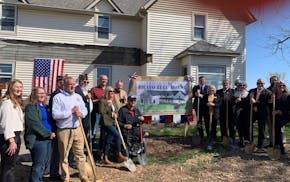DULUTH – Before last week, three of William A. Irvin's great-grandchildren had never been on his namesake ore boat, moored in the Duluth Harbor and one of the city's most iconic landmarks.
Irvin was president of U.S. Steel for six years in the 1930s. The 610-foot laker, christened in 1938, was the flagship of the steel company's Great Lakes fleet, becoming the Duluth Entertainment Convention Center's (DECC) floating maritime museum in 1986, eight years after its retirement.
When the siblings went through the attic of their parents' Ohio home after their mother died last year, they discovered a treasure trove from Irvin's past: a scrapbook with a Western Union telegram from President Dwight D. Eisenhower, a 1934 Business Week magazine with Irvin gracing the cover and a first edition set of Napoleon Hill's "The Law of Success," based on interviews with some of Irvin's likely influences, such as J.P. Morgan, who formed U.S. Steel.
Contemplating their great-grandfather's steel industry prominence, "takes your breath away," said Susan Barnett, of Dayton, Ohio.
Barnett and her sister, Cathie Hirsch of Detroit, and brother Robert Hirsch of Clearwater, Fla., traveled to Duluth last week to donate to the convention center several items they found in that attic.
Irvin was a regular guest on the ship with his second wife, Gertrude, said longtime tour guide and onetime Irvin crew member Cedric Woodard. He took Irvin's family through the boat, including its elegant guest rooms and the oak-paneled dining room where opulent meals were served.
Walking where William A. Irvin walked produced "chills," the siblings said.
The sisters, who drove to Minnesota together saw the brick-red vessel for the first time at night, when it was lit against the dark sky.
"We pulled up, and it was bigger than life," Cathie Hirsch said.
The 2,000-horsepower Irvin was built by the American Ship Building Co. in Lorain, Ohio, and sailed the Great Lakes for 40 years. The 83-year-old boat recently had a face-lift: Without a working engine, rudder or ballast, it was tugged to Superior's Fraser Shipyards in 2018 for restoration work, and brought back on a nail-biting journey in 2019. The boat cleared the narrow slip bridge opening with only inches to spare.
Most of the ship's historical items are from crew members and their families. That's why DECC internal operations director, Steve Rankila, was thrilled to get a call from Barnett with their findings.
"We were very excited to have the Irvin family share their great-grandfather's life with us," he said.
Irvin had five children with his first wife, one of whom is the grandmother of Barnett, Cathie Hirsch and Robert Hirsch. Irvin's 1952 New York Times obituary said the "self-made man" helped form the National Recovery Administration during Franklin D. Roosevelt's presidency that brought about fair business practices and empowered unions.
Under Irvin, U.S. Steel was the first Big Steel group to sign a bargaining contract with steel workers. He later became active in the National Safety Council where his work was said to have helped prevent millions of injuries and thousands of deaths.
He was pivotal in improving worker safety and supported unions, Barnett said, and in doing so, "he changed the lives of steel workers."
Seeing the boat helped the great-grandchildren form a new connection to the man they once knew so little about, they said.
Being here, Robert Hirsch said, "is very emotional."
Jana Hollingsworth • 218-508-2450

Hennepin County Attorney inks contract with D.C. law firm to prosecute trooper Londregan case

Defense attorneys in Feeding Our Future trial cast doubt on FBI's meal fraud investigation

Protesters hold dueling Gaza rallies at University of Minnesota

Overdose deaths spike after incarceration, but Minnesota jails lack treatment

